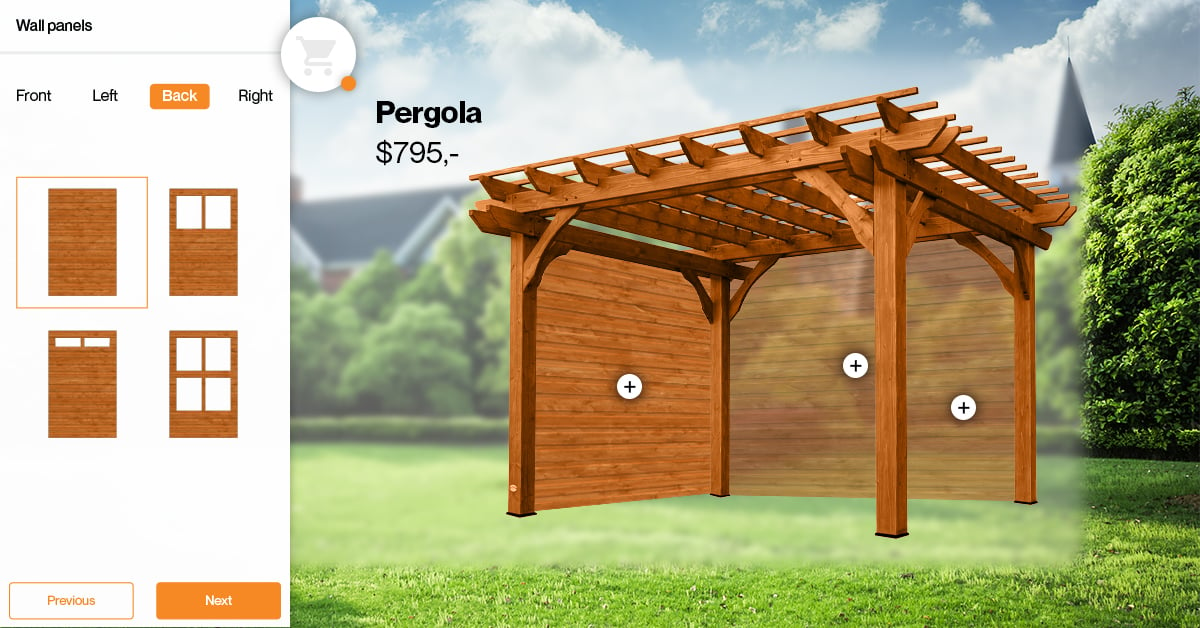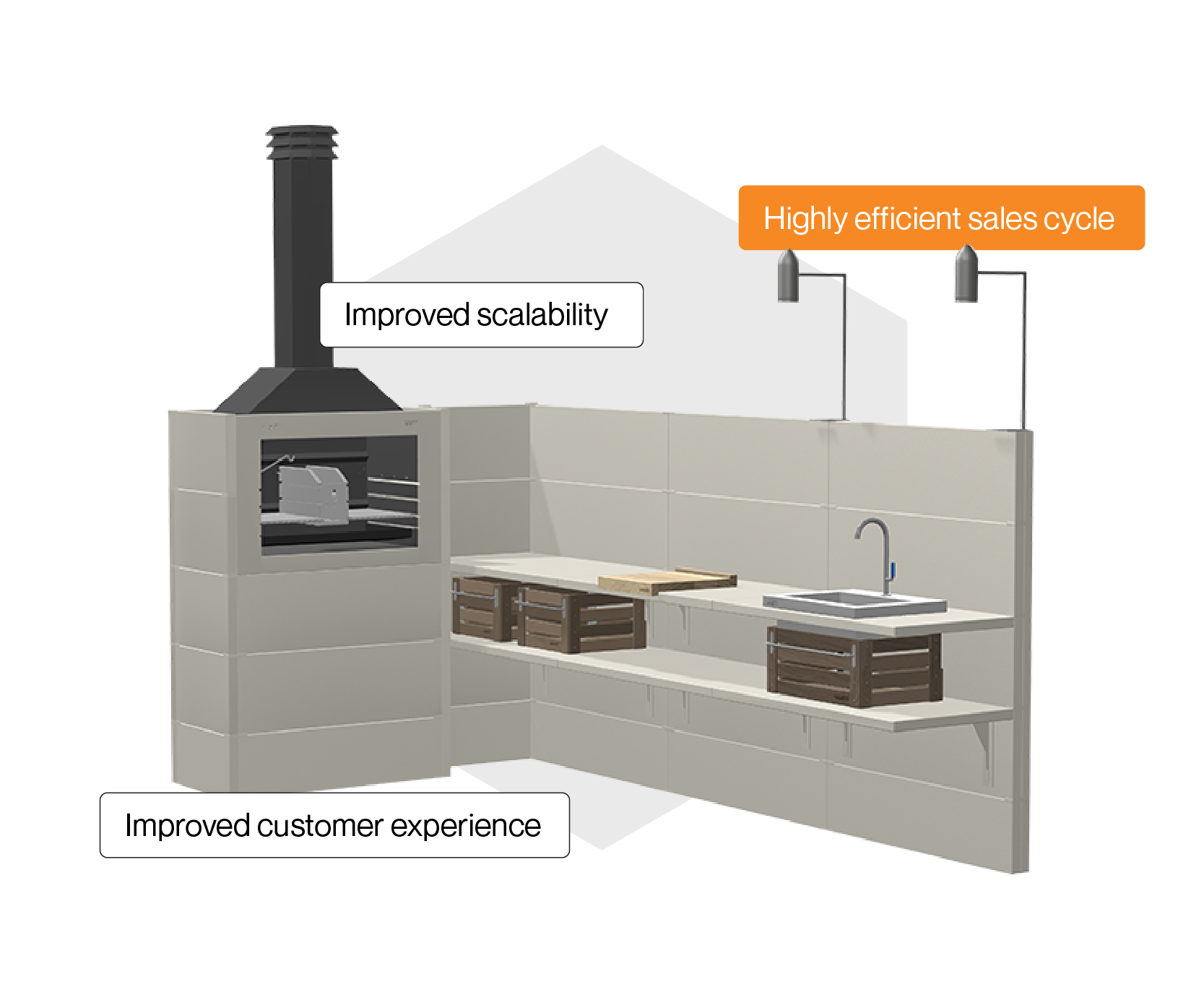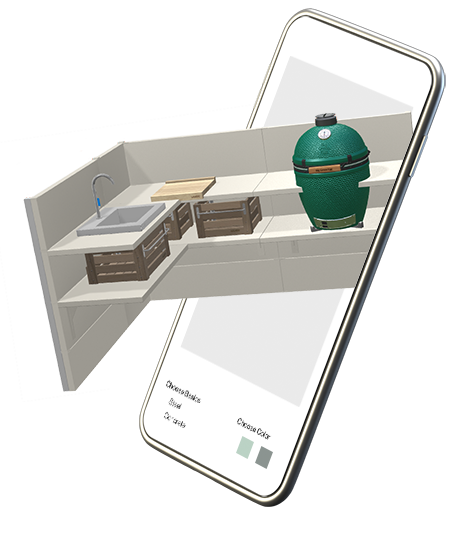How Outdoor brands can scale custom products without chaos
The outdoor industry is changing fast. Whether you sell outdoor kitchens, verandas, garden houses, saunas, modular structures or premium outdoor furniture, one thing has become very clear. Every customer wants something different, designed around their own space, style and budget.
That growing demand for customization is not the real problem. The real problem is that many outdoor brands still run their sales and production with manual tools, scattered data and processes that do not scale. The result is long quoting cycles, errors in dimensions, misaligned expectations, seasonal stress and a lot of pressure on sales and engineering teams.
This playbook looks at the outdoor market from a strategic perspective. We break down where complexity really comes from, how it affects your margins and what leading outdoor brands do differently. And we show how visual configuration and design to print workflows help you sell custom outdoor products at scale, without losing control.
This is not just a story about tools, it is a story about building a future proof outdoor business model.
Contents
- The outdoor industry has become a custom industry
- The real cost of outdoor customization
- Why legacy sales systems hold outdoor brands back
- The new rules of outdoor commerce
- What outdoor leaders are doing differently
- The outdoor configuration framework
- Outdoor workflows before and after automation
- Why configuration works so well for outdoor buyers
- How outdoor brands can start with Expivi
- The bottom line
The outdoor industry has become a custom industry
An outdoor product is almost never just a product. It is part of a complete outdoor space, with unique dimensions, ground levels, boundaries, sunlight and usage. That is why customers rarely ask for a standard model. They ask if you can make it slightly higher, a bit wider, in a different finish, or with a different roof type that fits their home and garden.
Outdoor brands therefore become custom manufacturers, even if their catalog is built on modular systems. The demand for personalization does not only come from high end customers. It is driven by consumer behavior in general. People design their outdoor spaces like an extra living room and expect the same level of choice and freedom they see online in other industries.
The real cost of outdoor customization
Custom outdoor products are attractive for customers and for your top line, but they put pressure on your operations and your margins when you manage them manually. In many projects, hidden costs add up silently in the background.
These are some of the biggest leaks we see in outdoor businesses before they automate their configuration and design to print workflows:
- Quoting time: manual calculations in spreadsheets or price books can take twenty to forty five minutes per request, especially if options need to be checked with engineering.
- Measurement errors: a wrong width or height in a garden house or veranda can lead to wasted materials, extra transport, rework on site and rescheduling crews.
- Internal misalignment: when sales, technical drawing and production each re interpret the order, mistakes slip in and have to be fixed downstream.
- Outdated documentation: static PDFs and price sheets do not reflect new options, material costs or compatibility rules, which leads to wrong quotes and margin erosion.
- Decision fatigue: when buyers are asked to make dozens of decisions without visual support, they delay, drop out or choose the safe, basic option.
- Seasonal overload: most inefficiencies hit during peak season, when every hour counts and staff are already at maximum capacity.
- Missed upsell: if customers cannot clearly see what extra modules, lighting or finishes add to their design, they will not add them to their basket.
In isolation, each of these issues may look manageable. Together, they define the true cost structure of customization. The more variation you sell, the more stress you see in your process, unless your configuration, pricing and production are tightly connected and automated.
Why legacy sales systems hold outdoor brands back
Many outdoor brands still operate with a familiar mix of Excel files, price books, manual drawings, PDF order forms and emails back and forth. That might have worked in a world where customers visited a showroom three times and accepted a long lead time between idea and quote. It does not fit a digital buyer journey where people compare options, check competitors and expect quick answers.
Legacy workflows make it hard to keep product information consistent, to update pricing centrally, to enforce product rules and to train new sales staff. Every new team member has to learn the catalog and the exceptions from scratch. Every new product variant adds complexity. Over time, the process slows down and the risk of miscommunication grows.
In practice, this means that the brands with the best product are not always the brands that win. The brands that make it easiest for customers to understand, configure and buy complex outdoor setups end up taking the lead. Experience, speed and clarity become the main competitive levers.
The new rules of outdoor commerce
Outdoor brands that grow with complex products tend to follow the same principles. They do not only digitise their catalog, they redesign how decisions are made, both by their customers and by their internal teams. From our work with outdoor brands, we see four new rules emerging.
Rule 1: visual clarity drives decisions
Customers deciding on a veranda, outdoor kitchen or garden shed need to see how everything comes together. Realistic 3D visualization, like the one in the WWOO outdoor kitchen configurator, gives buyers confidence. They understand proportions, material options and layout at a glance, without needing a technical drawing or long explanation.
Rule 2: product rules must be enforced inside the configurator
If a combination is technically impossible or does not meet your quality standards, the customer should never be able to select it. Instead of explaining rules in text or depending on sales memory, modern outdoor brands embed all rules into a central configuration engine. That is exactly what a 3D product configurator with CPQ logic, such as Expivi’s 3D configurator, is built to do.
Rule 3: sales and production need one source of truth
Every configured outdoor product should generate the same truth for every team. The sales quote, the bill of materials, the production work order and the price should all be based on the same configuration data. That eliminates double work, interpretation and re entry of information, and prevents the classic situation where the customer signed off on one thing and production builds another.
Rule 4: complex outdoor products should configure themselves
Modular outdoor products are perfect candidates for guided configuration. The more building blocks you have, the more value a smart configuration engine provides. Instead of manual calculations and guesswork, the system guides customers through valid choices, adjusts pricing in real time and produces the right output files. Complexity moves from your team into your platform.
What outdoor leaders are doing differently
The theory only matters if it leads to better practice. Outdoor brands that lead in personalization, like WWOO and NuBuiten, show what happens when visual configuration and smart logic are combined.
WWOO: modular outdoor kitchens made simple
WWOO offers modular outdoor kitchens that can be configured in many different ways. Before using a configurator, explaining all these combinations required time and expertise. With Expivi, WWOO now lets customers design their own outdoor kitchen in 3D, choose layouts, heights and accessories, and instantly see what is possible. This improves customer experience and keeps product rules under control at the same time. :contentReference[oaicite:0]{index=0}
NuBuiten: garden houses and verandas configured online
NuBuiten sells garden houses, sheds and verandas in many shapes and sizes. With Expivi’s 3D configurator, customers configure their own structure directly online, selecting dimensions, layouts and wood types that fit their garden and budget. The result is a smoother buying journey, fewer misunderstandings and a strong foundation for upsell on accessories and finishes. :contentReference[oaicite:1]{index=1}
These cases show a pattern. Leading outdoor brands do not avoid complexity, they organise it, so that their customers experience freedom and their teams experience control.
The outdoor configuration framework
To scale outdoor customization sustainably, you need more than a 3D viewer. You need a framework that connects product, price, visualization and production. At Expivi, we often guide outdoor brands through the same foundational steps.
First, we map the product logic. Which modules fit together, which roofs can be combined with which wall types, which spans are allowed, what are the minimum and maximum dimensions. This becomes the rulebook inside the configurator. Then we define the pricing logic, so every dimension and option translates directly into a correct price.
In parallel, we create or optimise the 3D assets, so that the visual experience reflects the real product. Customers can rotate, zoom and inspect details, which reduces doubts and questions. Finally, we automate the output. Each configuration generates a sales quote, a technical bill of materials and data for production systems, all from the same source.
For some brands, we also connect design to print, so that visual configurations directly create print ready files for walls, panels or branded elements, without manual file preparation. :contentReference[oaicite:2]{index=2}
Outdoor workflows before and after automation
The impact of this new way of working becomes more concrete when you compare the full workflow before and after implementation.
| Process step | Before automation | After automation |
|---|---|---|
| Quote creation | Twenty to forty five minutes per request | Instant calculation in the configurator |
| Product understanding | Several conversations and drawings needed | Clear 3D view of the final setup |
| Order accuracy | High risk of errors and rework | Around 99 percent correct configurations |
| Support load | Many questions by phone and email | Fewer questions thanks to visual clarity |
| Upsell on options | Depends on sales explanation | Consistent increase in average order value |
| Customer confidence | Mixed and fragile | High, supported by visualization and logic |
Why configuration works so well for outdoor buyers
Outdoor buyers behave differently from typical ecommerce shoppers. They are not just picking a product from a shelf, they are shaping a part of their living environment. That makes their decision more emotional, more personal and more sensitive to uncertainty.
Configuration addresses this on several levels. It gives customers control without overwhelming them, by guiding them through each decision step by step. It replaces abstract descriptions with concrete visuals that show how a product will look in their space. It answers questions about fit, compatibility and price in real time, instead of spreading them over multiple emails or meetings.
Most importantly, configuration lets buyers feel that the final product is truly theirs. That sense of ownership is powerful. Customers who co create their outdoor kitchen or veranda are more likely to complete the purchase, more likely to choose premium options and more satisfied when the product arrives, because it matches the vision they helped build.
How outdoor brands can start with Expivi
Many outdoor brands recognise themselves in the challenges described above, but they hesitate to change because it feels complex to digitise everything at once. In practice, the most successful projects start small and grow in clear stages, with a strong partner to guide the process.
At Expivi, we often advise outdoor brands to start with one flagship product line and then expand. A typical first implementation looks like this:
- Select a hero product line such as a popular veranda series, a modular outdoor kitchen or a best selling garden house.
- Define the configuration rules together with our team, mapping all valid dimensions, combinations and structural requirements.
- Create the 3D experience so customers can configure and visualise their setup in real time on your website or in your showroom.
- Automate pricing and documentation so each configuration directly generates the right price, bill of materials and order data.
- Connect your systems by integrating the configurator with your ecommerce platform, ERP and if relevant, your design to print workflow.
- Learn and iterate based on how customers use the configurator, which options they choose and where they drop off in the journey.
Once this first line runs smoothly and shows results, it becomes much easier to add more product lines, more modules and more channels. What starts as a single digital flagship quickly evolves into a new way of doing business across your entire outdoor assortment.
You can discover more outdoor and related cases on our cases overview and explore how other brands use Expivi to turn complex products into clear, visual experiences.
The bottom line
The outdoor market is moving from fixed products to flexible solutions, from generic catalogs to personal configurations and from manual quoting to automated, visual selling. Customers expect to design their own space and they expect brands to support that process in a simple and reliable way.
Brands that embrace this shift do not just make their process more efficient. They create a stronger buying experience, reduce errors, increase average order value and free their teams to focus on advice and quality rather than checking numbers in spreadsheets. They build an outdoor product economy that scales with demand instead of breaking under it.
If you recognise the challenges in your own business and want to see how a visual configurator and design to print workflow could work for your outdoor products, our team is ready to show you what is possible.
Book a free 15 minute demo with Expivi and explore how to turn complex outdoor products into a scalable, visual and customer friendly experience.


